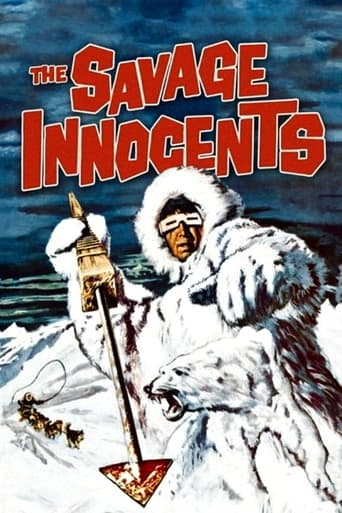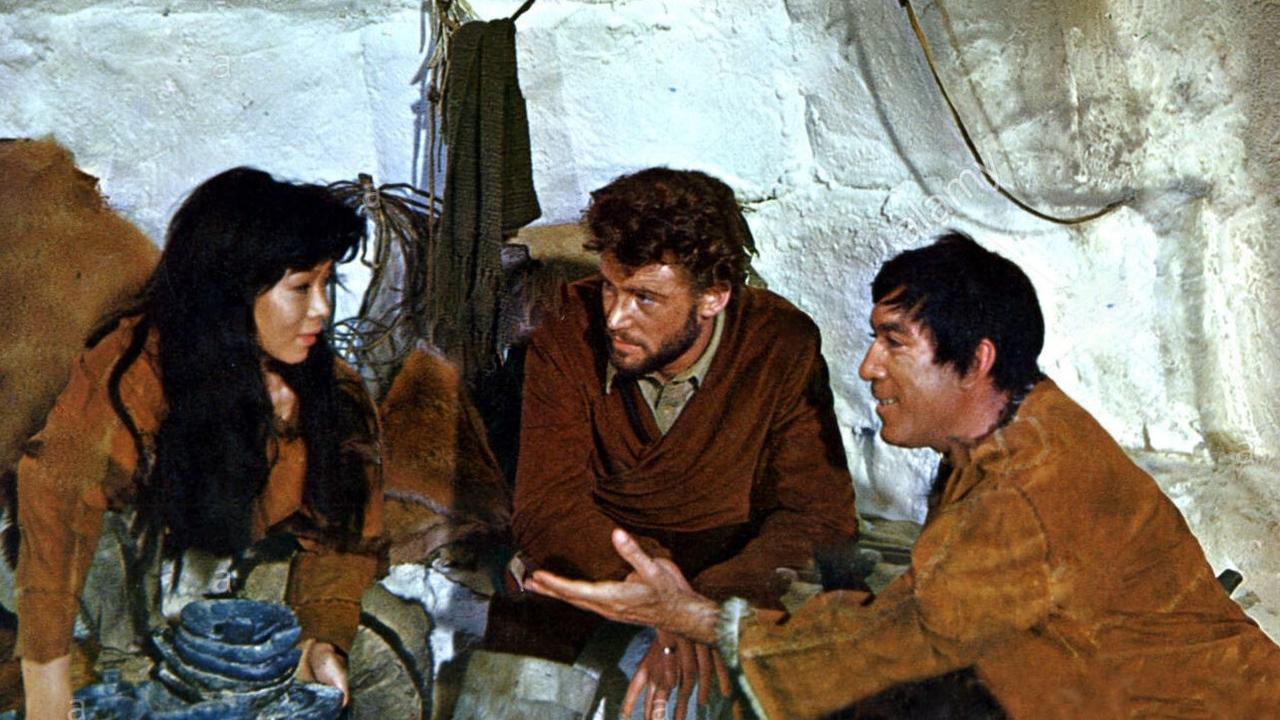blynelly
One of the stupidest most inaccurate movies I have ever seen! From a real live "raw meat eater". We didn't kill female babies, females are just as important as a male babies. And the part about sharing wives is such BS, culture had some wife swapping and to the Inuit people sex was something that happens not a taboo, people have sex that's how babies are made even we savages knew that.It's a MYTH that the elderly were left on ice flows or in a snow drift. In the Atomic age even us savages knew what a gun was and golly gee we even saw those metal birds a flyin over head. Ugh.Someone wrote "far northern natives that lived almost exclusively on the arctic ice". How stupid. Do you suppose we all lived in kayaks and Umiaks during the spring thaw and summer months? We hunted on the ice sometimes when we weren't hunting caribou deer and moose we are MEAT EATERS. No hunter would kill a dog to warm someones' hands', he would have never let the trooper get that bad to start with. A live dog would have warmed a person as well as pull you to a place you could get help. Or we would have eaten the animal should the need arise. Hunt a polar bear alone, ridiculous!And giving the dead seal a drink of fresh water. Unbelievable! Yes we would surely have given thanks to the animal spirits. Sea mammals don't drink fresh water, they get all the liquid they need from the foods they eat. Look it up. The clothes were authentic for sure but from different cultures of Inuit.All in all the reviews praising this movie for "culturally authentic" are from people who have no idea what they are talking about and believe all the things that they see in movies. It's a movie not a documentary. Par for the times they didn't hire real Inuit or even American Indians to play the parts Anthony Quinn and Japanese Chinese played as Inuit's is funny. Too that nobody would bother to hire on a real Inuit as a consultant was standard for the times.Entertaining maybe, insulting to THE MEN absolutely.
chaos-rampant
Inuk is a lonely Inuit hunter making ends meet in the barren, unforgiving wastes of the arctic regions by hunting seals and bears. So begins the glacial odyssey of one man against two worlds, his own and that of white man. In many ways a "northern", the frostbitten equivalent of the western (a genre director Nicholas Ray was familiar with), THE SAVAGE INNOCENTS shares many of the same themes and ideas with that most quintessentially American of genres - survival in a savage landscape, the frontier of civilization, the cultural clash between different civilizations. Yet no sight of spurs, stetson hats or six-shooters to be found in the movie. What other proof do we need that such ideas are universal? Filmed in the arctic regions of Canada and Greenland, and presenting us with a faithful and loving documentation of Inuit traditions and life, Ray on one hand captures the sheer monumental beauty of the harsh arctic wastelands with a kind of Kubrickian grandeur, while on the other reserving for his characters the utmost sympathy and affection. The stark realism of the uninviting climate contrasted with the good-natured predisposition and unpretentious simplicity of the people living in it. Realism meeting halfways with humanism in a movie that is as humorous and touching as it is cerebral, part survival grit and part mythological folklore. And then white man comes into Inuk's world. With his rifles, his loud rock'n'roll music, his missionaries preaching their god, his weird customs and laws. That doesn't mean that what precedes Inuk's encounter with the white men of a trading post and the preacher living there is an idyllic utopia - Inuk is ready to club another man to death for taking the woman he planned to make his wife. Still it would be easy to sneer sarcastically from the comfort of our modern homes at the primitive customs of Inuit. "In the age of the atom bomb", says the voice-over narrator, "these people still hunt with bow and arrow". Indeed they do; they also leave their elders alone to die in the snow when they become too old to contribute to the household anymore and they leave their firstborn babies to die unless they are male, so they can take care of them when they in turn grow old. But such is the nature of their lives and the environment they live in.Anthony Quinn's performance as Inuk is fantastic, equal measure good-natured forwardness and unreserved honesty. A man as likely to offer you his wife as he is to bash your brains in for refusing her. Peter O'Toole (two years before LAWRENCE OF ARABIA) in the role of the officer sent to arrest Inuk for the murder of the preacher doesn't match Quinn but he's a nice addition to the cast. The most dramatically poignant moments in the film come from their interactions as Inuk struggles to comprehend the crime he is accused of. "But my Fathers' laws have not been broken" he says when he is informed he broke the law and will have to be taken back for trial. "When you come to a strange land, bring your wives, not your laws" is what Inuk's wife tells the officer.A great, great movie I can't recommend enough to fans of tales of survival in stark environments, different cultures and their folklore. NANOOK OF THE NORTH and DERSU UZALA are advised to look out for it.
Jonathon Dabell
After an early body of work filled with noirish thrillers, director Nicholas Ray seemed to have a change of interest in the latter stages of his career. He became much more fascinated with making movies set in diverse locations, and exploring the cultural and ecological issues that the people from these places experienced. Movies like Bitter Victory, Wind Across The Everglades, The Savage Innocents and 55 Days At Peking belong in this late section of Ray's oeuvre. No film illustrates his enthusiasm for cultural diversity more than The Savage Innocents, a powerful, intelligent and informative film about Eskimo existence. The film ran into some censorship difficulties back in its day, mainly for depicting the Eskimo lifestyle with unflinching accuracy. The white characters in the film are often repulsed and appalled by certain Eskimo customs, and it seems that the very same customs had a similar effect on the censors.Inuk (Anthony Quinn) is a strong, handsome Eskimo who has spent much of his life waiting for the right woman to take as his wife. Since men far outnumber women in their society, it is viewed as a sign of hospitality if a man with a wife shares her with a man without one for sexual practises. Inuk is tired of "borrowing" women from his friends and is determined to find a suitable wife, which he eventually does when he chooses the attractive and hard-working Asiak (Yoko Tani) over her equally desirable sister Imina (Kaida Horiuchi). Inuk ekes out a constantly demanding existence by travelling around the frozen wastelands searching for food for his wife and her mother Powtee (Marie Yang). One day, he learns from another Eskimo that there is a white man's trading post nearby where he might purchase a gun that will make his hunting expeditions easier, safer and more successful. Inuk enthusiastically decides to visit the trading post, but when he arrives there a naïve and idealistic missionary (Marco Guglielmi) tries to talk to him about God and morality and Christianity. Confused, Inuk tries to show generosity by "lending" his wife to the missionary, but the man is appalled at the suggestion and refuses. This in turn insults Inuk, so he kills the missionary and leaves. Later, two Mounted Police officers (Carlos Justini and Peter O'Toole) hunt for Inuk to bring him to justice, barely realising that by his own Eskimo code he has done no wrong. Inuk is viewed as a murderer purely because white man has imposed his own laws upon the land.The conflict of civilised values is at the film's core. Some pretty gruesome things happen during The Savage Innocents, but within the context of the film they are not really gruesome at all. In perhaps the most memorable and powerful scene of all, O'Toole looks destined to lose his hands to frostbite. But Quinn kills one of his own dogs, cuts open its belly, and saves O'Toole's hands by shoving them inside and warming them on the dead dog's innards. The scene shows, in cold but authentic detail, how an Eskimo might survive against the elements by doing what a white man would consider uncivilised. The first three quarters of the film unfold in a fascinating, almost documentary-like manner. The final section becomes slightly more conventional, dealing with the Mountie's pursuit of Inuk. Having said that, there's still a fascinating irony in the way that the Eskimo cannot understand why they want him so badly, while they look upon him with the utmost contempt as a savage killer. At times slow and symbolic, at others powerful and enthralling, The Savage Innocents is definitely a film that deserves a look (especially in its uncensored form which is now widely available on DVD).
wild-plum
In the late sixties, bob dylan was asked how he came to write the song "Quinn the Eskimo". He replied that he'd seen this movie in which Tony Quinn played an Eskimo. The Savage Innocents is that movie. (In a much later book about his lyrics, Dylan says he doesn't remember how the song came about- like many of us, ol' bob's memory ain't what it used to be.)This is the most accurate portrayal of Eskimo customs ever to come out of Hollywierd. It contrasts the cultural practices of Inuit and North American societies at a time when many Inuit people had not yet encountered the white man and his ways. The movie asks the question "who is savage and who is innocent?" The movie is full of memorable performances and "sound bites". You'll come away with a new appreciation for traditional Eskimo culture and more than a few new quotable quotes.When Quinn the Eskimo gets here, everybody's gonna jump for joy!


 AD
AD



